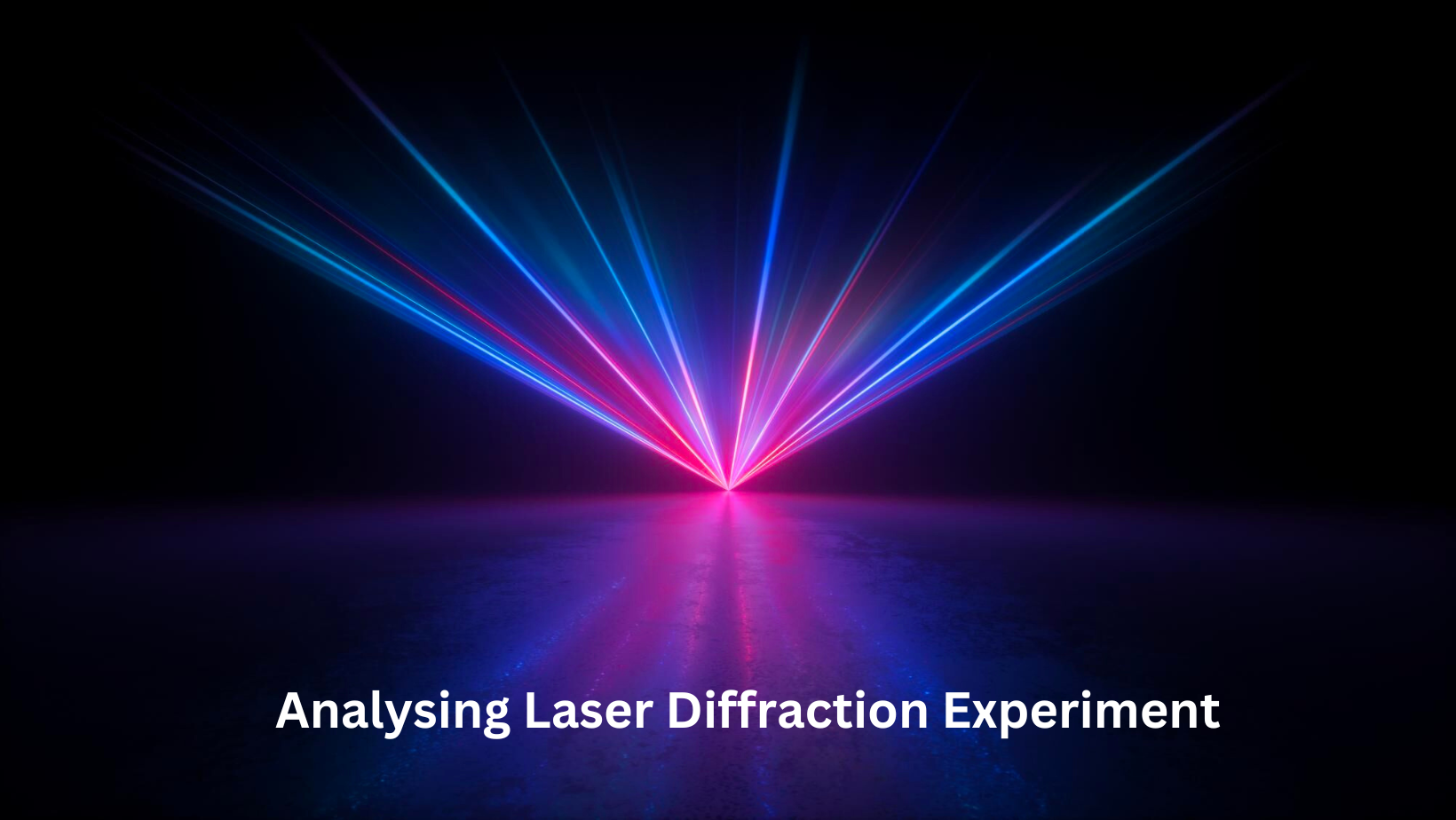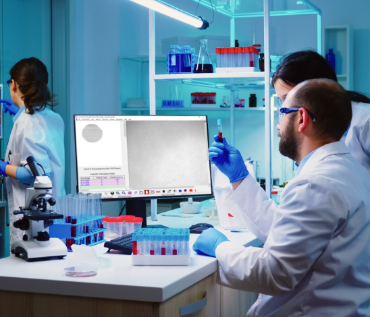Table of content
1. What is Wrong with the Laser Diffraction Experiment?
2. How Does the Laser Diffraction Experiment Operate and What Does It Entail?
3. Advantages and applications
4. What Role Does Laser Diffraction Experiment Play in the Pharmaceutical Sector?
5. What are the Drawbacks and Limitations of the Laser Diffraction Experiment?
6. Conclusion
What is Wrong with the Laser Diffraction Experiment?
An essential component of pharmaceutical research, development, and quality control is particle size analysis. It is quite important to figure out how effective, stable, and safe pharmaceutical items are. Due to its simplicity of use and quick findings, laser diffraction has become one of the most well-liked particle size measurement methods. However, a thorough analysis of laser diffraction techniques reveals several drawbacks and difficulties that need to be resolved for precise particle size estimation in pharmaceutical applications.
How Does the Laser Diffraction Experiment Operate and What Does It Entail?
The size distribution of particles in a sample may be determined using the commonly used experimental technique known as laser diffraction. When a substance is in the form of solid particles, liquid droplets, or even gas-borne aerosols, it gives important information about the range of particle sizes that are present in that material. The method, which is based on the laws of light diffraction and scattering, is particularly helpful in the fields of materials research, medicines, and environmental monitoring. Let's look more closely at the laser diffraction experiment:
The Fundamentals of Laser Diffraction:
The interaction between particles in a sample and a laser beam is the fundamental component of the laser diffraction experiment. Due to interactions with individual particles, a laser beam that passes through a suspension of particles scatters its light in different directions. The diffraction pattern is the name given to this scattering pattern.
Setup of a Laser Diffraction Experiment:
- Laser Source: The experiment starts with a laser source that generates coherent (in-phase), monochromatic (single-wavelength), and light. Helium-neon (He-Ne) lasers and diode lasers are frequently employed in laser diffraction investigations.
- Sample Dispersion System: To guarantee that particles are equally distributed and kept apart from one another, the particle sample is suspended in a liquid medium (often water). To get correct findings, a sample must be well dispersed since aggregates or clumps might skew data.
- Optical System: A mixture of lenses, mirrors, and beam splitters guides the laser beam through the sample. The laser beam must enter the sample at a certain angle thanks to the optical system's engineering.
- System of detection: After passing through the sample, the scattered light is gathered by a detector that is angled differently about the laser beam that was incident. The strength of the dispersed light is measured by this detecting device at various angles.
Data collection and analysis:
The scattering pattern that results from light being scattered by the sample's particles in various directions includes details on the particles' sizes and locations. The term "scattering pattern" or "diffraction pattern" refers to this pattern. Researchers can ascertain the particle size distribution in the sample by examining this pattern.
In a laser diffraction experiment, the following main factors are analyzed:
Measurement of dispersed light must take into account the scattering angle. Larger particles scatter light at smaller angles than smaller particles, with smaller angles being more common for smaller particles. Calculating the particle size distribution requires this angle-dependent data.
- Intensity of Scattered Light: Information on the quantity and size of particles that scatter light at each angle is available from the intensity of scattered light at that angle.
- Laser wavelength: An important factor in precisely determining particle sizes is the laser's recognized wavelength.
- Software and an Optical Model: To analyze the scattering data and establish the particle size distribution, researchers employ specialized software and mathematical models. Analysis of the particle size distribution
The program analyses the scattering data and creates a particle size distribution curve, which is often shown as a cumulative distribution plot or histogram. The percentage of particles in the sample falling into particular size ranges is indicated by this graph.
Advantages and applications
A few benefits of laser diffraction include its rapid speed, broad measuring range, and non-destructive sampling. It has uses in many different domains, including:
- Pharmaceuticals: Examining the size of the drug-formulation particles.
- Environmental science: investigating air quality and aerosols.
- Material Science: Characterising powders, nanoparticles, and colloidal solutions in the field of materials science.
- Food Industry: evaluating the quality of food items, such as powders and emulsions, in the food industry.
In conclusion, laser diffraction is an effective experimental method for figuring out particle size distributions in a variety of materials. It is predicated on the thorough examination of the diffraction pattern produced by the laser light being scattered by particles in a sample.
What Role Does Laser Diffraction Experiment Play in the Pharmaceutical Sector?
The pharmaceutical sector utilizes laser diffraction extensively as a useful analytical method. Particle size analysis and pharmaceutical product quality control are its main applications in this field. The pharmaceutical sector uses laser diffraction in the following ways, in particular:
Pharmaceutical formulation quality control & R&D: It's essential to guarantee the correct particle size distribution. The particle size can affect a drug's bioavailability, rate of dissolution, stability, and overall efficacy whether it is administered as a liquid suspension or in solid dosage forms such as tablets and capsules. To confirm that the particle size distribution complies with the requirements stated in the medication formulation, laser diffraction is performed.
An industry pioneer in physical testing with a significant emphasis on image analytics is ImageProVision Technology. Their cutting-edge products, which include ipvClass, ipvPSA, ipvAutoClass, ipvPCount, ipvAutoCount, IPVNano, ipvPHot, ipvMicrobe (compatible with 21CFR Part 11), and ipvproofcheck, are offered to pharmaceutical companies to meet their specific demands. Because of their expertise in in-depth picture processing, R&D laboratories can precisely estimate the size and form of particles.
Their flexible apps provide the pharmaceutical sector with powerful tools for picture processing and analysis. Visit their website to see how image analytics may be used to its greatest advantage in pharmaceutical research and development.
- Particle Size Analysis of Active Pharmaceutical Ingredients (APIs): Active pharmaceutical ingredients (APIs) are often found in the form of powders or crystals in pharmaceutical medications. The size distribution of these APIs is determined using laser diffraction. For guaranteeing the consistency and homogeneity of medicinal products, this information is crucial.
- Inhalation product quality control: To guarantee optimal lung deposition and therapeutic efficacy, inhalation products such as dry powder inhalers (DPIs) and metered-dose inhalers (MDIs) require precise control over particle size. The particle size distribution of the inhalable drug particles is evaluated using laser diffraction.
- Drug Delivery: Drug delivery methods for nanoparticulate drugs are being developed by pharmaceutical businesses as a result of the development of nanotechnology. The size distribution and polydispersity of nanoparticles may be characterised using laser diffraction in combination with other methods, which is essential for medication administration and targeting.
- Particle size: Particle size measurement is essential to determining stability, shelf life, and efficacy in liquid pharmaceutical formulations, including suspensions and emulsions. To check on the size of suspended or emulsified particles and guarantee even distribution, laser diffraction is utilised.
- Excipient Characterization: Excipients (inactive substances) utilised in pharmaceutical formulations are characterised using laser diffraction in addition to APIs. For constant product performance, excipient particle size control is crucial.
- Bioavailability studies: Knowledge of the size of medication particles can help determine how readily and quickly they dissolve in the body. During the creation and improvement of drugs, this knowledge is especially helpful.
- Research and Development: To better understand how particle size affects medication delivery, release kinetics, and other pharmacological features, researchers in the pharmaceutical industry employ laser diffraction. New medicine formulations and delivery methods can be developed with the help of this.
- Regulatory compliance: As part of the drug approval process, regulatory agencies like the U.S. Food and Drug Administration (FDA) frequently demand pharmaceutical companies to produce data on particle size distribution. A recognized and acknowledged technique for satisfying these legal standards is laser diffraction.
In conclusion, laser diffraction is essential for guaranteeing the reliability, security, and effectiveness of medicinal items. The pharmaceutical sector may create reliable and efficient medication formulations, enhance product performance, and adhere to regulatory requirements by precisely measuring and managing particle size.
What are the Drawbacks and Limitations of the Laser Diffraction Experiment?
Although laser diffraction is a useful method for analyzing particle size, there are certain restrictions and drawbacks that researchers should be aware of:
- Laser diffraction assumes that the particles are spherical. When working with non-spherical particles like fibers, platelets, or irregularly shaped particles, this assumption might result in errors. To overcome this constraint, specialized methods or modeling may be needed.
- Refractive Index Variation: Understanding the refractive indices of the particles and the suspending medium is essential for accurate particle size characterization. Errors in size measurements may result from differences in refractive index inside the sample. Consistency in refractive index values must be maintained.
- Limited Size Range: Laser diffraction cannot be used to measure very big or very minute particles. The design of the equipment and the laser's employed wavelength determine the size range that can be precisely measured.
- Effects of multiple scattering: Before being noticed, dispersed light can interact with several particles in samples with high particle concentrations. The scattering pattern may become distorted as a result, necessitating adjustments.
- Effects of Absorption: When the sample's particles have a high absorption coefficient, they may absorb some laser light, which might skew readings. Corrections are required to consider the effects of absorption.
- Challenges with Sample Dispersion: It can be difficult to achieve proper sample dispersion, which is the state in which particles are evenly dispersed and do not cluster or clump. Results may be erroneous if dispersion is inadequate.
- Laser diffraction can tell you about a particle's size, but it cannot tell you about the shape of the particle. In many applications, it's important to understand both size and form, which may need the application of complementary methods.
- Complex Sample Matrix: The substance in which particles are suspended can occasionally be a complex sample matrix with several phases or components. The analysis and interpretation of data may be hampered by its intricacy.
- High Instrument Cost: High-quality laser diffraction equipment can be pricey, making it harder for some researchers or organisations to use them.
- Operator Knowledge and Skill: Effective use of laser diffraction equipment requires operator skill and knowledge. Operators with little experience could make mistakes or interpret results incorrectly.
- Sample Size: In laser diffraction investigations, the sample size may be constrained, which might have an impact on the measurement's representativeness, especially for heterogeneous materials.
- Uncertainty in Calibration: Accurate calibration of the equipment is essential for producing data that can be trusted. Calibration mistakes might result in inaccurate size readings.
To address these shortcomings, researchers often employ complementary techniques, such as microscopic particle size and shape analysis, Electron microscopy for shape information, or dynamic light scattering (DLS) for measuring smaller nanoparticles. Additionally, a lot of the problems related to laser diffraction may be mitigated by carefully preparing samples, calibrating equipment, and analyzing data. For particle size analysis to produce relevant and reliable data, it is essential to understand the method's limits. Following are the detailed drawbacks of the laser diffraction experiment.
False Assumptions in Laser Diffraction:
The independence of the scattering events and the totality of the individual events is one of the essential tenets of laser diffraction. For very non-spherical particles, this assumption might not hold even though it does in many other situations. Laminar flow, which causes non-spherical particles in the majority of laser diffraction systems to align themselves with the flow direction and generate inaccurate readings of particle size, has been established in research. This phenomenon, called "flow alignment," has an impact on the precision of laser diffraction measurements, especially for particles with a large aspect ratio.
It is likewise dubious to assume that volume distribution is provided by laser diffraction. Although it is said that laser diffraction findings represent volume distribution, they are volume-weighted since the analytical equation includes a cubed radius factor. As a result, data are produced that are more appropriately referred to as surface area data. According to studies, plates and cubes with equal linear dimensions but very different volumes cannot be distinguished by laser diffraction equipment.
Accuracy vs. Precision:
In particle size analysis, the difference between accuracy and precision is essential. When measuring the same sample again, laser diffraction may yield incredibly consistent findings, which is why it is frequently complimented for its accuracy. However, accuracy is not always guaranteed by precision alone. Precision is the consistency of repeated measurements, whereas accuracy is the similarity of measured values to the real values.
According to research, transparent spherical particles are the only kind of particle that laser diffraction devices tend to be accurate for. Laser diffraction measurements may differ greatly from the true particle sizes when used on irregularly shaped or opaque particles. Laser diffraction undercounts events produced by bigger dimensions in situations involving acicular particles, such as needles or rods, which causes an overestimation of the contribution of smaller dimensions and results in erroneous observations.
Challenges in Algorithm and Software:
Processing data from laser diffraction requires sophisticated proprietary numerical algorithms that change over time and between instrument manufacturers. These algorithms' lack of transparency makes them difficult to validate and rely on. It is challenging to maintain accuracy since users of laser diffraction equipment frequently have limited access to the inner workings of the program.
Additionally, the data produced by laser diffraction devices might be distorted and artifacts introduced depending on the method and software used. It is important but not always easy to choose the right method for a particular particle system, especially when working with non-spherical particles.
The Role of Refractive Indices:
For laser diffraction to yield trustworthy findings, both the sample and the solution must have precise refractive indices. Particle size measurements may be inaccurate as a result of variations in refractive index values. Refractive indices are supposedly only required to be exact to within 0.2 for findings to be trustworthy, but in practice, matching refractive indices may be a difficult task, especially for anisotropic particles.
Validation and Comparison with Other Techniques:
Validation studies are necessary to resolve the limits of laser diffraction. However, typical laser diffraction technique validation frequently emphasizes precision above accuracy. Comparison studies with other particle sizing methods, such as electron microscopy, time-of-flight, or time-of-transition methods, are required to confirm the accuracy of particle size analysis.
Conclusion
In conclusion, laser diffraction has drawbacks and difficulties, especially in pharmaceutical applications, despite its speed, repeatability, and convenience of use. For non-spherical particles, it's possible that the laser diffraction assumptions won't hold, which will result in incorrect readings. Validation and dependability are further complicated by the usage of proprietary software and methods.
It's important to distinguish between accuracy and precision since laser diffraction equipment has only been demonstrated to be accurate for a limited range of particle sizes and shapes. Refractive index matching is a difficult operation that needs to be well thought out. It is critical to carry out validation studies that go beyond accuracy and incorporate comparisons with other particle sizing techniques to guarantee accurate particle size analysis in pharmaceutical applications. The pharmaceutical sector will benefit from improved particle size procedures as a result of addressing these problems.




